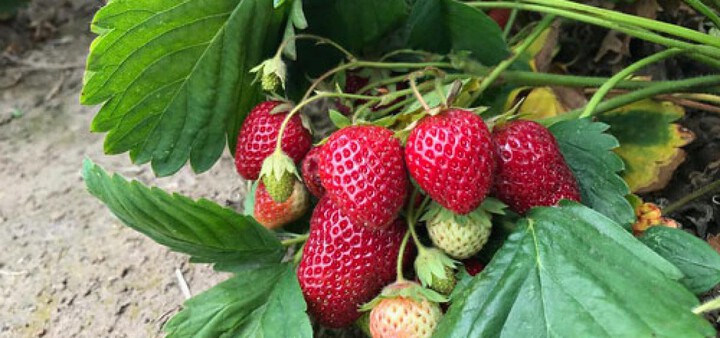
CORVALLIS, Ore. – Now that many people are staying home, interest in gardening – especially edible gardening – has skyrocketed. Strawberries are a no brainer for both beginning and experienced gardeners and you’ll find nurseries well stocked in spring with potted plants.
Recognizing how important gardening is in times of crisis, many nurseries have remained open, at least for curbside pickup. Plants should be put in the ground as soon as possible as long as root systems in the pot are well developed.
Strawberries are self-pollinating, so you don’t need to pair them with another variety to increase yield like you do with blueberries, said Javier Fernandez-Salvador, Oregon State University Extension berry specialist. Strawberries have better yield and larger fruit with increased pollination from bees, so keeping a bee-friendly garden is a good idea.
Before buying plants, need to know before buying plants is what type of strawberry you want: June-bearing (also known as short day), everbearing or day-neutral. As the name implies June-bearing plants produce berries primarily in June; everbearing give two main crops in early summer and fall with few in between; and day-neutral yield all summer except sometimes when temperatures reach 85 degrees to 90 degrees, depending on the cultivar.
Day-neutral types are what most home gardeners will want unless they need a large batch of berries all at once to freeze or make jam, Fernandez-Salvador said. Most of the June-bearing strawberries are sweeter, redder and more aromatic than the day-neutral types so they are widely available in commercial markets. They separate from the green cap (calyx) easier and do not have a long shelf life.
Once you’ve decided on the type of strawberry to grow, you’ll want to choose a variety. For June-bearing, there’s ‘Hood,’ which gives one good flush of berries in June and July and is the standard bearer for flavor. But most people will lean toward the day-neutral varieties. ‘Albion’ has large fruit and stores well for fresh eating. ‘Seascape,’ which thrives in Oregon, bears smaller fruit throughout the season. Readily available in the ever-bearing category is the older variety ‘Quinault,’ but its popularity is not what it was before better varieties arrived on the market.
More varieties are recommended in Strawberry Cultivars for Western Oregon and Washington by Bernadine Strik, Extension berry specialist. There are a few suggested for colder areas, as well. Charts in the publication indicate when and how much the plant bears; type of berry and flavor; and susceptible diseases. For gardening at the beach check out Growing Berries on the Oregon Coast: Strawberries.
Plant in full sun for best production. Build a raised bed 12 inches high by tilling in organic material, preferably compost, but anything is better than nothing.
There are two ways to plant strawberries – the matted-row and hill systems. Matted-row is preferred for June-bearers and hill for day-neutral and everbearers. To make a matted-row planting, place berries 12 to 15 inches apart in 2-foot-wide rows with beds 3 to 4 feet apart. The runners, which root and make new plants, will fill in the rest of the space and result in a dense planting. As the runners grow outside of the bed, push them back into the bed where they’ll make new plants.
In the hill system keep plants 12 to 15 inches apart alternating in double- or triple-wide rows. Aisles should be 1 ½ to 2 feet wide. Cut off all runners every two to three weeks. It’s best to wait until runners have formed “daughter” plants but have not rooted. This will give you one large plant in each spot instead of the daughters produced in the matted-row system.
Use a balanced fertilizer with the three numbers (percent nitrogen, phosphorus and potassium) on the front label equal or close to equal – 16-16-16, for example. Check the label and divide the overall amount recommended by the number of applications needed throughout the season. June-bearing strawberries get fertilizer following renovation after the fruit is finished. Everbearers and day-neutrals get several applications throughout the season. Refer to the above publication for more detailed instructions. Use a garden tool or broom to sweep fertilizer off leaves and always water after feeding.
Don’t be dismayed if strawberries don’t bear much the first year. Plants will produce a full crop the next year and two to four seasons after that before production dwindles. At that point, new plants will need to go in. Start a new patch in the year your existing one is in its last season so you don’t skip a year of fruit. Day-neutral strawberries, however, should only be kept for two years in Oregon and will produce a nice crop the first year, Fernandez-Salvador said. Remove the first two flushes of flowers to encourage a well-developed root system.
To get maximum yield, never let plants be stressed by lack of water. Keep newly set strawberries well irrigated with about 1 to 1½ inches of water a week. Don’t saturate the soil – strawberries dislike wet feet. Let the soil dry out to the touch (up to the first knuckle) before watering down to 6 to 8 inches. Strawberries don’t do well with weeds so if you irrigate properly the plant will grow stronger and outcompete the them.
Annual renovation is necessary for June-bearers but not day-neutral or everbearing. After June-bearers have finished producing berries, use a string trimmer or rotary mower and cut plants to about 2 inches above the crown. Remove the debris, but don’t rake vigorously or you’ll damage the crowns.
Strawberries are susceptible to verticillium wilt so it’s a good idea to rotate beds periodically, especially for day-neutrals. Spotted wing drosophila can be a pest; the best control is to keep your beds clean. Pick berries regularly, try to avoid a wet environment and keep runners pruned. The natural pesticide spinosad, sold under various brands, is one of the best treatments if they do get started on your fruit.